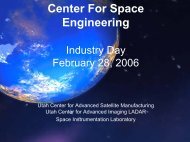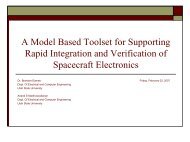LIDAR Assisted Rendezvous and Docking - Center for Space ...
LIDAR Assisted Rendezvous and Docking - Center for Space ...
LIDAR Assisted Rendezvous and Docking - Center for Space ...
You also want an ePaper? Increase the reach of your titles
YUMPU automatically turns print PDFs into web optimized ePapers that Google loves.
USU LADARSIM Ladar Simulator• USU LADARSIM was developed <strong>for</strong>NAVAIR <strong>and</strong> incorporatesper<strong>for</strong>mance-related parametersassociated with the laser, detector,signal processing, scannerdynamics, plat<strong>for</strong>m dynamics,navigation errors, <strong>and</strong> sceneproperties to provide generalsystem analysis, error sourcemodeling, <strong>and</strong> 3-D points clouds .Original Solid ModelRange Error14 cmNoiseless Point Cloud ModelNoisy Point Cloud Model
II I IZ point = R point -ptransZ pX py pR pointPx pointp transZ cIx pointy cX c
Complex singularitiesMean field assumption with singularity in the complex β plane:−∂P/∂β ∝ ln((1/β m − 1/β) 2 + Γ 2 ) ,Fisher zeros should stabilize at a distance Γβ 2 m from the real axis when thevolume increases.Large order behavior consistent with P(β) − P pert. (β) ≃ C(a/r 0 ) 4 , witha(β) defined with the <strong>for</strong>ce scale with r 0 = 0.5 fm.Bounds: 0.001 < Γ < 0.0113
Minimizing the Error Metric• The final step in the ICP algorithm was to compute an error metric that thealgorithm uses as a measure to the success of the calculated registration<strong>for</strong> each iteration.• For most applications, a mean square error (MSE) or sum of the squareddistance between corresponding points after the calculated registration wasapplied <strong>for</strong> point-to-point methods.MSE=1 N∑Ni=1vyi− R12vxi−vp122• Similarly, a MSE between corresponding points <strong>and</strong> matched planes can beused.NvMSE = n ⋅( A i− B i)∑i=1
Three-Axis Rotation Simulation ResultsPoint-to-Point vs Point-to-PointNo Noise NoisyThree Axis Rotation (º) (º)Maximum Mean Angular Error 1.79 2.54Minimum Mean Angular Error 1.46 1.85Average Mean Angular Error 1.69 2.211σ - St<strong>and</strong>ard Deviatiation 1.32 1.82No Noise NoisyThree Axis Rotation (º) (º)Maximum Mean Angular Error 0.0546 0.8Minimum Mean Angular Error 0.0522 0.349Average Mean Angular Error 0.0532 0.4621σ - St<strong>and</strong>ard Deviatiation 0.03 0.325
Three Axis Rotation:Error dependence on rotation anglePoint-to-Plane
Number of Points vs. Error <strong>and</strong> Computation Time
Conclusions• Completed testing of accelerated <strong>and</strong> robust version of the point-to-point<strong>and</strong> point-to-plane ICP algorithm.• Implemented ICP/Point-Plane Algorithm– Significant accuracy improvement when compared to ICP/Point-Pointalgorithm• 14 cm error: 0.325º 1-σ error• 0 cm error: 0.037º 1-σ error– Currently analyzing more realistic 2 cm error conditions.– Incorporating translational correction algorithm– Initialization is way too slow <strong>for</strong> real-time work
Future Works <strong>and</strong> Tasks Underway• Investigating Real-Time initialization using Mach Filters, Spin Filters,or other possible options.• Preparing <strong>for</strong> experimental data recording <strong>and</strong> analysis fromCanesta system– Major data h<strong>and</strong>ling problem discovered <strong>and</strong> corrected• Modification of LadarSim to incorporate moving spacecraft






